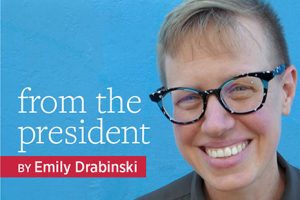
As I move into the final quarter of my term as president of the American Library Association, I’m taking stock of what I’ve learned.
At an academic library conference in Edison, New Jersey, I discovered that a Taylor ham and a pork roll are somehow both the same and different. In Morgantown, West Virginia, I learned that a pepperoni roll is indeed a delicacy, and I was grateful to be stuffed full of them at an event. And at the Sharjah International Book Fair in the United Arab Emirates, I learned at the hotel buffet that I should always get the lime pickle at breakfast, lunch, and dinner.
Along the way I’ve also learned more about the profession. School libraries are sanctuaries for our most vulnerable students. Rural public libraries are singularly nimble American institutions. Special collections librarians collect, preserve, and make accessible materials of enduring historical value, creating conditions for deep and diverse approaches to research. That’s just the start of a very long list.
And I’ve learned a whole lot more than I ever thought I’d want to know about Robert’s Rules of Order. Alongside the state chapter visits, agenda setting, and strategic thinking that make up this gig, the primary responsibility of ALA president is to serve as the presiding officer of the Executive Board. Our formal charge is to “act for Council in the administration of established policies and programs” and to make “recommendations with respect to policy and operation.” In practice, that means we make a lot of decisions. Robert’s Rules are one of the tools we use to do that. As presiding officer, it’s my job to facilitate that process.
When I’m teaching a classroom of students about something that may seem boring, I always try to lead with the why. My APA vs. MLA spiel on citation styles always includes a meditation on time in the humanities. I’ll admit that Robert’s Rules initially seem completely dull—they were the one thing I dreaded about this position.
At my first training session with ALA Parliamentarian Adrian Stratton, I learned why we use these sometimes-arcane rules at meetings of the Executive Board and Council: They’re one way to get everyone’s best ideas in front of us so we can make the best possible decision. They ensure that our agendas reflect what’s most urgent, that we use our time to talk to one another, and that everyone gets an opportunity to speak. As presiding officer, facilitating our collective decision making is my most important job.
I am proud to lead a democratic organization, one where many diverse voices can take the mike and the gavel. As this issue hits the presses, members will be asked to cast votes for our next set of ALA leaders—not just the consequential position of president but also a wide array of other offices, including representatives to Council, the governing body of the Association, and leadership positions across the divisions and round tables that give ALA its rich texture.
Of course, voting is only one expression of democracy. Democracy also means cultivating institutions that enable all of us to have the capacity and opportunity to shape our collective future well beyond the ballot. Voting to determine whether it’s Taylor ham or pork roll (it’s pork roll) doesn’t matter much if we don’t also have the rest of what we need for breakfast. As president, it’s also my job to ensure that our organizational infrastructure is healthy and that we have sufficient resources to meet our mission.
Figuring out how to manifest that mission in the here and now? That’s the work of all of us.

